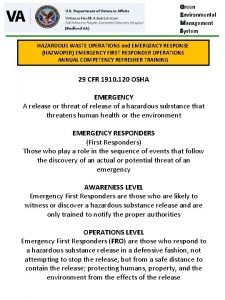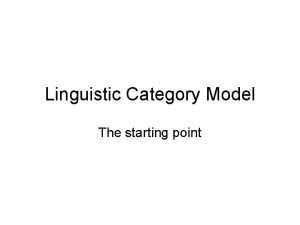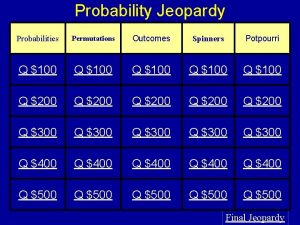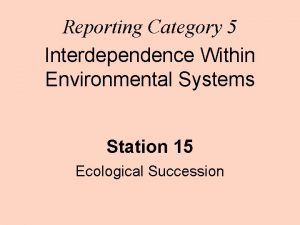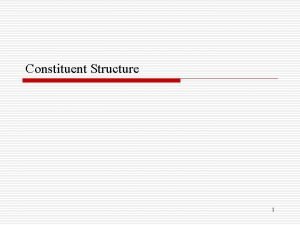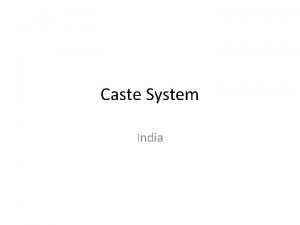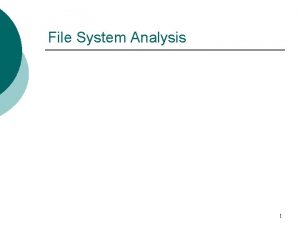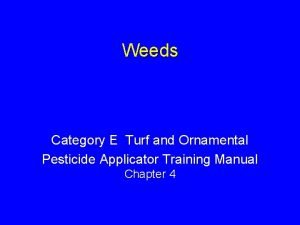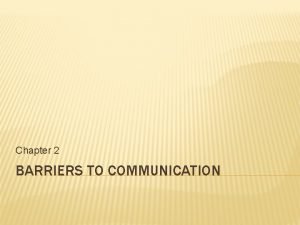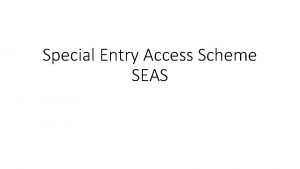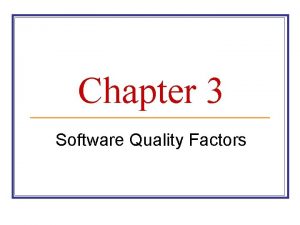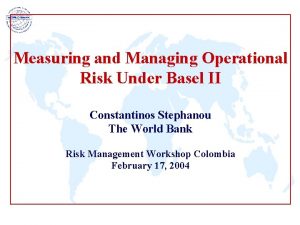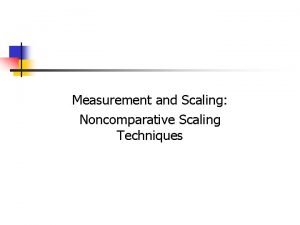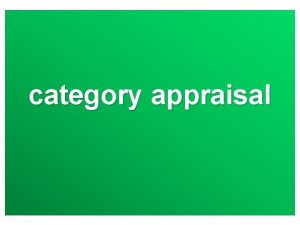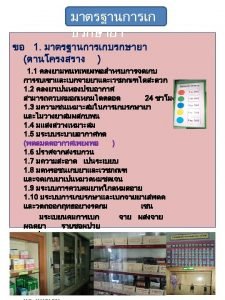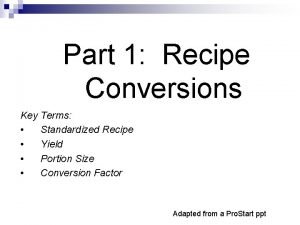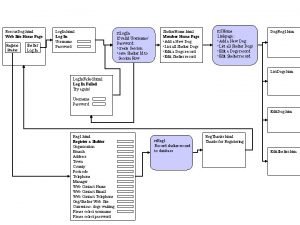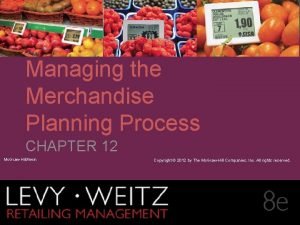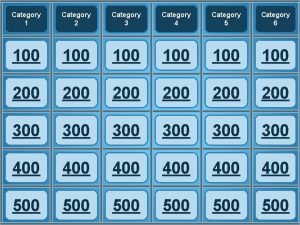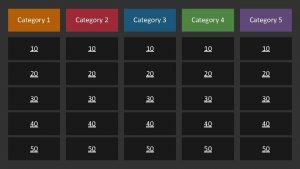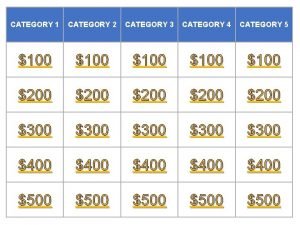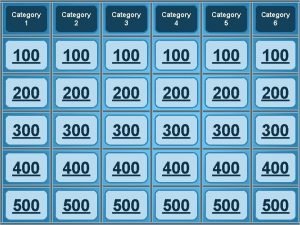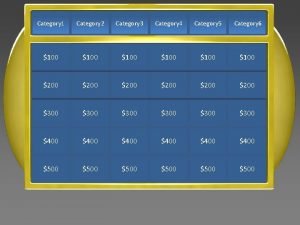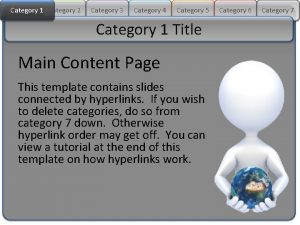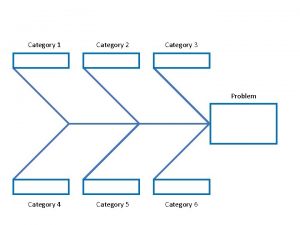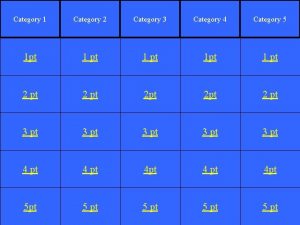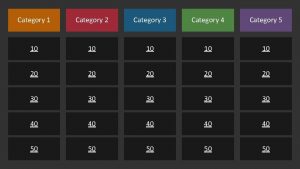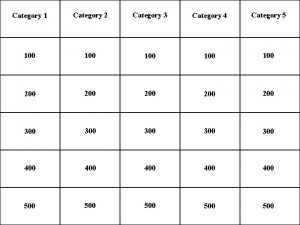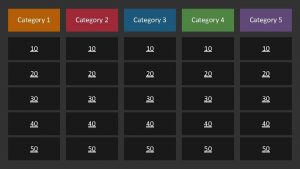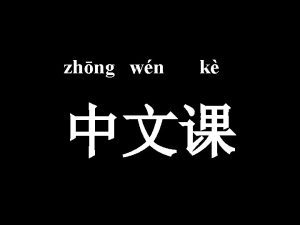Adding an Item Category Concept Adding an Item


































































- Slides: 66

Adding an Item Category Concept

Adding an Item Category

Adding an Item Category Step 1 Begin by navigating to the Category Definition page. Click the Items menu.

Adding an Item Category Step 2 Click the Define Controls menu.

Adding an Item Category Step 3 Click the Item Categories menu.

Adding an Item Category Step 4 Click the Add a New Value menu.

Adding an Item Category Step 5 Click in the Category field.

Adding an Item Category Step 6 Enter the desired information into the Category field. Enter "AGRI 1".

Adding an Item Category Step 7 Click the Add button.

Adding an Item Category Step 8 The Category Definition page enables you to enter the category description and determine the bank account, primary buyer, and lead time attributes.

Adding an Item Category Step 9 Use the Market Code field to select the coding scheme that a category code is using. Values are: UN/SPSC (Universal Standard Products and Services Classification) and User Def. (user defined).

Adding an Item Category Step 10 The Effective Date field specifies the date from which this item category is valid. It defaults to the current system date, but you can change it if needed.

Adding an Item Category Step 11 Use the Status field to select a category status. Changing a category status from Active to Inactive means that you can no longer assign items to the category. This status change does not affect the existing and future People. Soft Purchasing transactions involving items in the inactivated category. For example, setting a category status to Inactive has no effect on orders that you have in progress that contain items tied to the newly inactivated category. You can also continue to add these items to the People. Soft Purchasing transactions using the usual methods, such as entering an item ID directly on the online page or using the Order By Catalog page or Item Search Criteria page.

Adding an Item Category Step 12 Click in the Description field.

Adding an Item Category Step 13 Enter the desired information into the Description field. Enter "Agricultural products".

Adding an Item Category Step 14 When you navigate out of the Description field, the Short Desc field automatically populates with the first 10 characters of the Description field. You can use this default or change it if desired.

Adding an Item Category Step 15 Click in the Primary Buyer field.

Adding an Item Category Step 16 Enter the desired information into the Primary Buyer field. Enter "MGR 2".

Adding an Item Category Step 17 Click in the Lead Time Days field.

Adding an Item Category Step 18 Enter the desired information into the Lead Time Days field. Enter "30".

Adding an Item Category Step 19 Click in the Currency field.

Adding an Item Category Step 20 Enter the desired information into the Currency field. Enter "USD".

Adding an Item Category Step 21 Use the Account field to enter a valid account number to identify the general ledger account to be associated with the items in this category. This account number is used on transactions when no item ID is specified at the line level of a People. Soft Purchasing purchase order and no default account is specified for the transaction. Click in the Account field.

Adding an Item Category Step 22 Enter the desired information into the Account field. Enter "154000".

Adding an Item Category Step 23 Use the Usage Code field to enter an ultimate use code to default on to purchasing transactions whenever this category is referenced on an ad hoc (order by description) line. In most cases, sales tax is computed as a use tax based on the tax code applicable to the ship to or usage destination. However, how merchandise is ultimately used may also result in a different tax rate within the same ship to or usage destination.

Adding an Item Category Step 24 Use the Physical Nature list to indicate if the object is a physical good or service. Values are: Goods and Services.

Adding an Item Category Step 25 Use the Asset Profile ID field to enter an asset profile ID for the category. Asset profile IDs are transferred to People. Soft Asset Management when People. Soft Purchasing receives an item that specifies both an asset profile and an People. Soft Asset Management business unit. When you define a purchase order or requisition line using an asset category without specifying an item, the asset profile of that category becomes the default. Asset profile IDs are set up on the Asset Profile page.

Adding an Item Category Step 26 Click the Category Definition 2 tab.

Adding an Item Category Step 27 Use the Category Definition 2 page to define the matching and receiving controls, sourcing controls, and miscellaneous controls and options for the category. Also use this page to set price tolerance defaults for items to trigger workflow exception notifications. People. Soft Purchasing and People. Soft Payables use matching controls to match receipts, purchase orders, and vouchers. Receiving controls specify how receiving users process items assigned to this category. These values become a part of the item default hierarchy and can default to purchase order lines where this category is specified.

Adding an Item Category Step 28 Click the Expand All link.

Adding an Item Category Step 29 Use the Matching Controls section to specify default price tolerances for the People. Soft Payables Matching process, which matches purchase orders, receipts, and vouchers to verify supplier charges. When you use matching with People. Soft Purchasing and People. Soft Payables to verify supplier charges, the system uses four price tolerances to determine whether the purchase order price and voucher price are within the tolerances and thus whether the purchase order and purchase order voucher match. If you leave any of the tolerance fields set to 0 or blank, the system assumes a zero tolerance. If you don't want to use the tolerance fields, set the amount fields that you don't want to use to 9999999 and the percentage fields that you don't want to use to 100%.

Adding an Item Category Step 30 Use the Unit Price Tolerance and % Unit Price Tolerance fields to enter the matching tolerance amount and percentage for the price of an individual item. By using the Tolerance Over and Tolerance Under fields, you are entering the amount or percentage over or under the tolerance value entered that still enables a voucher match.

Adding an Item Category Step 31 Click in the Unit Price Tolerance field.

Adding an Item Category Step 32 Enter the desired information into the Unit Price Tolerance field. Enter "100".

Adding an Item Category Step 33 Click in the % Unit Price Tolerance field.

Adding an Item Category Step 34 Enter the desired information into the % Unit Price Tolerance field. Enter "1".

Adding an Item Category Step 35 Use the Ext Price Tolerance and % Ext Price Tolerance fields to enter the matching tolerance amount and percentage for the extended price (amount multiplied by quantity) of the item. The extended price tolerance is the tolerance for the entire order, not just an individual item.

Adding an Item Category Step 36 Click in the Ext Price Tolerance field.

Adding an Item Category Step 37 Enter the desired information into the Ext Price Tolerance field. Enter "100".

Adding an Item Category Step 38 Click in the %Ext Price Tolerance field.

Adding an Item Category Step 39 Enter the desired information into the % Ext Price Tolerance field. Enter "0. 5".

Adding an Item Category Step 40 Use the Receiving Controls section to define tolerances to be used in receiving this item. These become the default values for purchase order lines when this item is selected.

Adding an Item Category Step 41 Use the Receiving Required list to select the receiving requirement for the item. Values are: • Do Not: If selected, accounts payable matching and receipt accrual are not applicable. • Optional: If selected, accounts payable will not match receipt lines and the system will not accrue the receipt. • Required: If selected, accounts payable will match receipt lines and the system will accrue the receipt.

Adding an Item Category Step 42 People. Soft Purchasing offers an inspection component that provides detailed inspection instructions established by your item administrator. The People. Soft Inspection component enables you to define procedures for verifying the acceptability of received quantities of an item. Select the Inspection Required option to require inspection and to make the other inspection fields available for entry.

Adding an Item Category Step 43 Click the Inspection Required option.

Adding an Item Category Step 44 Use the Reject Qty Over Tolerance option to indicate that you want to reject a quantity that surpasses the tolerance limits that you set.

Adding an Item Category Step 45 Click the Reject Qty Over Tolerance option.

Adding an Item Category Step 46 Use the Inspect ID (inspection ID) field to enter the inspection IDs, which are established on the Inspection Routing page.

Adding an Item Category Step 47 Click in the Inspect ID field.

Adding an Item Category Step 48 Enter the desired information into the Inspect ID field. Enter "STANDARD".

Adding an Item Category Step 49 Use the Inspection UOM (inspection unit of measure) list to select from the following: • Standard: Select to perform inspections in the standard UOM set up on the Item Definition - General: Common page. • Supplier: Select to perform inspections in the UOM used on the purchase order to the supplier.

Adding an Item Category Step 50 Click the Inspection UOM list.

Adding an Item Category Step 51 Click the Supplier list item.

Adding an Item Category Step 52 Use the Partial Qty (partial quantity) list to select the action that you want to take if you receive less than the quantity specified on the purchase order schedule. Select from: • Open: Select to receive the partial quantity, leave the receipt line status as Open, and enable the receipt to be saved. • Open/Error: Reject the partial quantity, leave the receipt line status as Open, and generate an error message. • Open/Warn (open, but with a warning): Receive the partial quantity, leave the receipt line in Open status, and generate a warning message. • Recvd (received): Receive the partial quantity and change the receipt line status to Recvd. • Recvd/Warn (received with a warning): Receive the partial quantity and change the receipt line status to Recvd, but also generate a warning

Adding an Item Category Step 53 Click the Partial Qty list.

Adding an Item Category Step 54 Click the Open/Warn list item.

Adding an Item Category Step 55 Use the Early Ship Rjct Days (early shipment rejection days) field to enter the acceptable number of days before a shipment date during which you will still receive the goods.

Adding an Item Category Step 56 If you select Cumulative Split in the Sourcing Method field, the Accumulate Level field becomes available for entry. Select Run to accumulate the percentage for the supplier based on each run of the PO Calculations process, or select Schedule to accumulate based on each schedule.

Adding an Item Category Step 57 Use the Sourcing Method list to select from Basic, Cumulative Split, Flexible, and Sched Split (split schedule).

Adding an Item Category Step 58 In the Cumulative Sourcing group box, set the options for the cumulative sourcing method. The fields in this group box become available if you select Cumulative in the Sourcing Method field.

Adding an Item Category Step 59 Click the Save button.

Adding an Item Category Step 60 Click the OK button.

Adding an Item Category Step 61 You are prompted to update the item catalog. If you click the Yes button, you will be prompted to enter the catalogs. This requires that the catalog is current and set up prior to entering the category. If you click the No button, you can simply save the item category. Here, you are adding an item category.

Adding an Item Category Step 62 Click the No button.

Adding an Item Category Step 63 Notice that the system has generated a new category ID for your item category.

Adding an Item Category Step 64 You have successfully added an item category to the system. End of Procedure.
 Erate category 2
Erate category 2 Minecraft items
Minecraft items Metaphor adalah
Metaphor adalah Real self vs ideal self poster
Real self vs ideal self poster Perbedaan pemasaran dan penjualan
Perbedaan pemasaran dan penjualan Lexical category
Lexical category Swift category 7
Swift category 7 Seas statement of support examples
Seas statement of support examples Rapidity usd 259
Rapidity usd 259 Classical category structure
Classical category structure Fire hazard category
Fire hazard category Management of allergic rhinitis
Management of allergic rhinitis Word formation processes and examples
Word formation processes and examples Category 0
Category 0 Linguistic category model
Linguistic category model Doubtful 1 assets
Doubtful 1 assets Stagecraft tools
Stagecraft tools Efundamentals category analytics
Efundamentals category analytics Potpourri jeopardy
Potpourri jeopardy Tactogram
Tactogram Dyslexia vulnerability
Dyslexia vulnerability Category 5 interdependence within environmental systems
Category 5 interdependence within environmental systems Syntactic category list
Syntactic category list Aryans of india
Aryans of india File system category
File system category The category of mood
The category of mood Lexical category
Lexical category Turfgrass pest management (category 3a practice test)
Turfgrass pest management (category 3a practice test) Category 5 and 6 local authority districts
Category 5 and 6 local authority districts Category 1 cell structure and function
Category 1 cell structure and function Pregnancy category a
Pregnancy category a The drug basket method used to dispense medication to
The drug basket method used to dispense medication to Category e turf and ornamentals
Category e turf and ornamentals Florida building code 2010
Florida building code 2010 Number synoynm
Number synoynm Interpersonal and intrapersonal barriers to communication
Interpersonal and intrapersonal barriers to communication Category 2 road
Category 2 road Seas atar calculator
Seas atar calculator Rapiprazole
Rapiprazole Software quality factors example
Software quality factors example What is genre
What is genre Was magellan worth defending
Was magellan worth defending A category or type of literature
A category or type of literature Lexical category
Lexical category Measuring and managing operational risk
Measuring and managing operational risk Category 3 biological evolution and classification
Category 3 biological evolution and classification Reading genres
Reading genres Bi-rads 2
Bi-rads 2 Non comparative scale
Non comparative scale Category appraisal
Category appraisal Category
Category What is w4 category university
What is w4 category university Category 5 interdependence within environmental systems
Category 5 interdependence within environmental systems Cpcs 2021 salary table
Cpcs 2021 salary table Category of accident
Category of accident Fetal heart rate monitor
Fetal heart rate monitor Nursing process stages
Nursing process stages Category of evidence
Category of evidence Nexdum
Nexdum Category 4 pressure ulcer
Category 4 pressure ulcer 6 parts of a standardized recipe
6 parts of a standardized recipe Prior reference category
Prior reference category Jeopardy potpourri questions
Jeopardy potpourri questions Marpol color code for garbage
Marpol color code for garbage Dog.html?avd= site:com
Dog.html?avd= site:com Radial category
Radial category Types of merchandise management planning process
Types of merchandise management planning process










